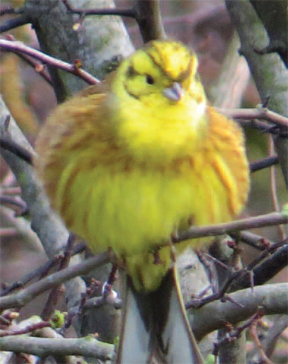| Wildlife
Newsletter for the Township of Dalkey April / 2016 - Michael Ryan |
||
| FEBRUARY MARCH APRIL MAY JUNE JULY AUGUST SEPTEMBER OCTOBER NOVEMBER DECEMBER |
|
|
I
hadn’t been out birdwatching at Rogerstown Estuary for years
so when we did decide to go in late February we were fortunate to
have one of the nicest days of the month which, though cold, was dry
and sunny. There was enough heat in the air to provide perfect warm
air thermals for soaring buzzards and we saw at least seven circling
above us at various times. On the last time I’d been there I
remember everyone on the Birdwatch branch outing getting excited by
seeing a buzzard perched on a fence but now they’ve got so common
in North Dublin they’d only generate interest if there weren’t
any present. The land, a very substantial area comprising 220 acres,
previously contained allotments and farmland where a number of tillage
crops were grown but is now managed by Fingal Council and a lot of
the area is managed for wildlife with over 40,000 trees planted by
local |
| When
we’d seen our fill of wildfowl we wandered back getting lovely
views of a pair of Stonechat. It was still relatively early in the day so we thought we’d stop off at Broadmeadow Estuary in Swords on our return journey. Another spot I’d once frequented regularly that I hadn’t been to in years, Broadmeadow remains the same apart from the fact there are colossal stone pillars rising out of the bank to support the north and south bound lanes of the NI with a constant stream of traffic humming overhead. When the motorway’s route was originally proposed there were fears the swans that frequent the estuary in large numbers might land on the roadway, especially in wet weather when the glistening surface might be mistaken for water, causing potential catastrophe on the road but thankfully that hasn’t happened and lots of people still drive to the estuary to feed the swans especially on Sundays. We parked nearby and approached the waterside and as we neared a culvert bringing a stream underground into the estuary a blaze of turquoise lashed out, two kingfishers who are apparently regulars there. We spotted Snipe and watched Wigeon, Redshank, Dunlin, Black tailed Godwits and many more ducks and waders feeding ahead of the fast approaching tide. The sun had gone behind the clouds and we were feeling the sharp breeze so we headed back to the comfort of the car but as we began to put away our scopes Lucy spotted, a few yards away in a clump of trees the unmistakable vivid yellow glow of a Yellowhammer. As bright as any canary this particular individual added to its spectacular presence by having its feathers fluffed up so it looked like a small vivid feather duster. We spotted more on the other side of the road moving through the hedge while our ‘dandy’ stayed perched near us giving us great views. We’d got to see them after all. |
 A fluffed up male Yellowhammer near Broadmeadow Estuary at Swords |